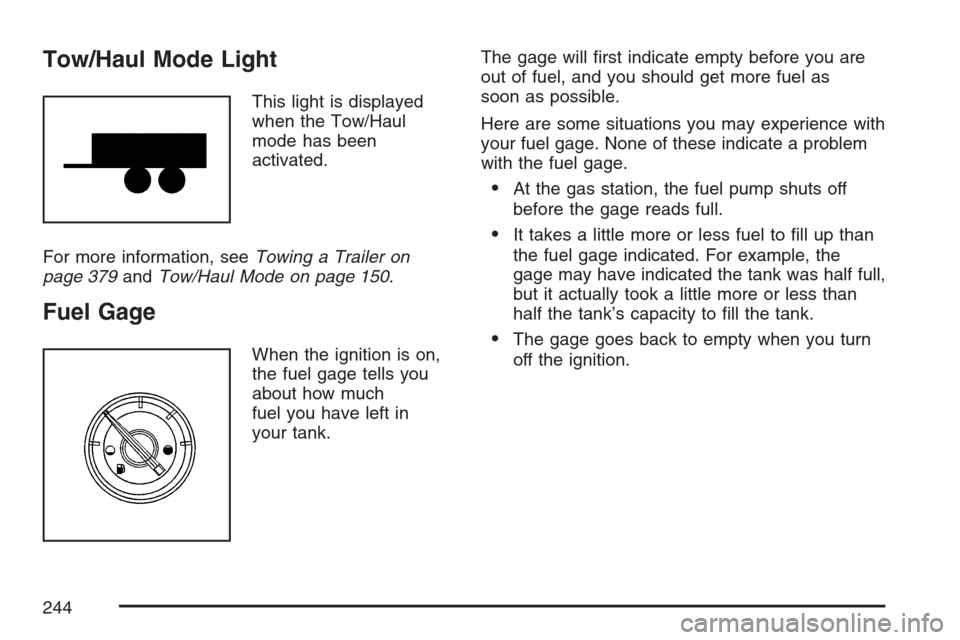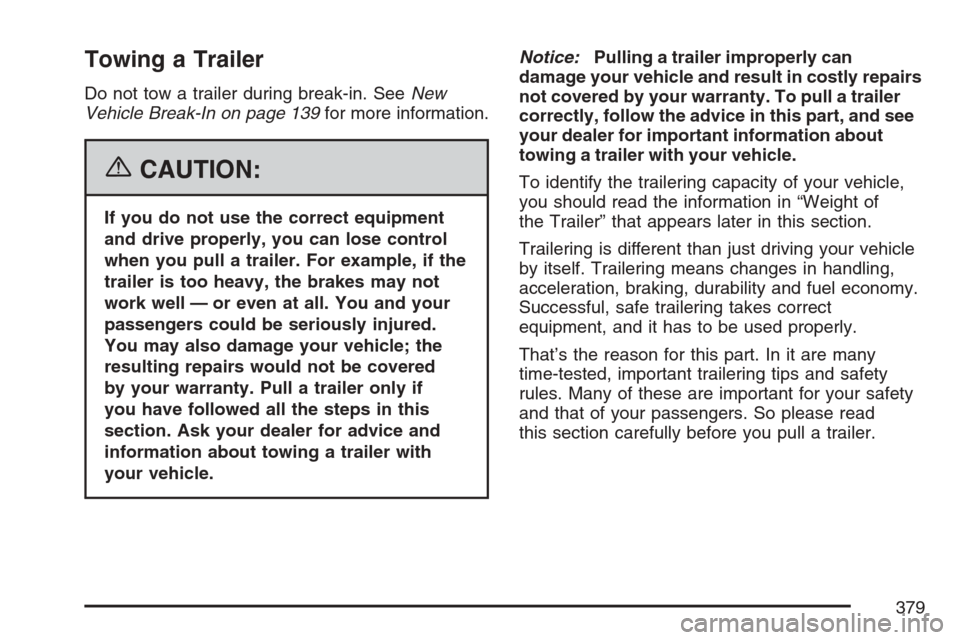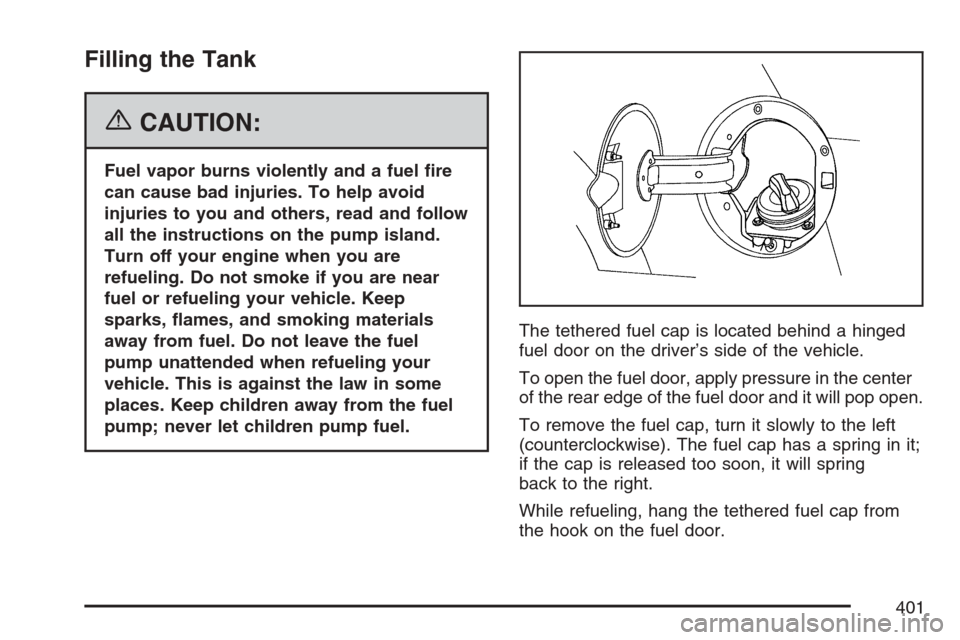fuel cap CADILLAC ESCALADE ESV 2007 2.G Owners Manual
[x] Cancel search | Manufacturer: CADILLAC, Model Year: 2007, Model line: ESCALADE ESV, Model: CADILLAC ESCALADE ESV 2007 2.GPages: 574, PDF Size: 2.89 MB
Page 240 of 574

This light should come on, as a check to show
you it is working, when the ignition is on and the
engine is not running. If the light does not
come on, have it repaired. This light will also
come on during a malfunction in one of two ways:
Light Flashing— A mis�re condition has
been detected. A mis�re increases vehicle
emissions and may damage the emission
control system on your vehicle. Diagnosis and
service may be required.
Light On Steady— An emission control
system malfunction has been detected on your
vehicle. Diagnosis and service may be
required.
If the Light is Flashing
The following may prevent more serious damage
to your vehicle:
Reducing vehicle speed
Avoiding hard accelerations
Avoiding steep uphill grades
If you are towing a trailer, reduce the amount
of cargo being hauled as soon as it is
possibleIf the light stops �ashing and remains on steady,
see “If the Light Is On Steady” following.
If the light continues to �ash, when it is safe to do
so, stop the vehicle. Find a safe place to park
your vehicle. Turn the key off, wait at least
10 seconds and restart the engine. If the light
remains on steady, see “If the Light Is On Steady”
following. If the light is still �ashing, follow the
previous steps, and see your dealer for service as
soon as possible.
If the Light Is On Steady
You may be able to correct the emission system
malfunction by considering the following:
Did you recently put fuel into your vehicle?
If so, reinstall the fuel cap, making sure to fully
install the cap. SeeFilling the Tank on page 401.
The diagnostic system can determine if the fuel cap
has been left off or improperly installed. A loose or
missing fuel cap will allow fuel to evaporate into the
atmosphere. A few driving trips with the cap
properly installed should turn the light off.
240
Page 244 of 574

Tow/Haul Mode Light
This light is displayed
when the Tow/Haul
mode has been
activated.
For more information, seeTowing a Trailer on
page 379andTow/Haul Mode on page 150.
Fuel Gage
When the ignition is on,
the fuel gage tells you
about how much
fuel you have left in
your tank.The gage will �rst indicate empty before you are
out of fuel, and you should get more fuel as
soon as possible.
Here are some situations you may experience with
your fuel gage. None of these indicate a problem
with the fuel gage.
At the gas station, the fuel pump shuts off
before the gage reads full.
It takes a little more or less fuel to �ll up than
the fuel gage indicated. For example, the
gage may have indicated the tank was half full,
but it actually took a little more or less than
half the tank’s capacity to �ll the tank.
The gage goes back to empty when you turn
off the ignition.
244
Page 258 of 574

The message could be displayed if the
stability system takes longer than usual
to complete its diagnostic checks due to
driving conditions.
If an engine or vehicle related problem has
been detected and the vehicle needs
service, the message will appear. See your
dealer.
The message will also appear if the vehicle is
shifted into 4LO.
The message will turn off as soon as the
conditions that caused the message to be
displayed are no longer present.
TIGHTEN GAS CAP
If the vehicle’s fuel cap is not tightened properly,
this message may display along with the check
engine light on the instrument panel cluster.
SeeMalfunction Indicator Lamp on page 239.
Reinstall the fuel cap fully. SeeFilling the Tank on
page 401. The diagnostic system can determine
if the fuel cap has been left off or improperly
installed. A loose or missing fuel cap will allow fuel
to evaporate into the atmosphere. A few driving
trips with the cap properly installed should turn this
light and message off.
TIRE LEARNING ACTIVE
If your vehicle has a Tire Pressure Monitor (TPM)
system, this message will display when the
system is re-learning the tire positions on your
vehicle. SeeDIC Operation and Displays on
page 245for more information. The tire positions
must be re-learned after rotating the tires or
after replacing a tire or sensor. SeeTire Inspection
and Rotation on page 467,Tire Pressure Monitor
System on page 462, andIn�ation - Tire
Pressure on page 460for more information.
TRACTION CONTROL OFF
If your vehicle has StabiliTrak®, this message will
display when the traction control system is
turned off. Adjust your driving accordingly. See
StabiliTrak
®System on page 330for more
information.
258
Page 373 of 574

Item Description Total
AVehicle Capacity Weight
for Example 3=1,000 lbs (453 kg)
BSubtract Occupant
Weight 200 lbs
(91 kg)×5=1,000 lbs (453 kg)
CAvailable Cargo
Weight=0 lbs (0 kg)
Refer to your vehicle’s tire and loading
information label for speci�c information about
your vehicle’s capacity weight and seating
positions. The combined weight of the driver,
passengers, and cargo should never exceed
your vehicle’s capacity weight.
Certi�cation/Tire Label
A vehicle speci�c Certi�cation/Tire label is attached
to the rear edge of the driver’s door.
The label shows the size of your vehicle’s original
tires and the in�ation pressures needed to obtain
the gross weight capacity of your vehicle. This is
called Gross Vehicle Weight Rating (GVWR).
The GVWR includes the weight of the vehicle,
all occupants, fuel, and cargo.
The Certi�cation/Tire label also tells you the
maximum weights for the front and rear axles,
called Gross Axle Weight Rating (GAWR).
Example 3
373
Page 379 of 574

Towing a Trailer
Do not tow a trailer during break-in. SeeNew
Vehicle Break-In on page 139for more information.
{CAUTION:
If you do not use the correct equipment
and drive properly, you can lose control
when you pull a trailer. For example, if the
trailer is too heavy, the brakes may not
work well — or even at all. You and your
passengers could be seriously injured.
You may also damage your vehicle; the
resulting repairs would not be covered
by your warranty. Pull a trailer only if
you have followed all the steps in this
section. Ask your dealer for advice and
information about towing a trailer with
your vehicle.Notice:Pulling a trailer improperly can
damage your vehicle and result in costly repairs
not covered by your warranty. To pull a trailer
correctly, follow the advice in this part, and see
your dealer for important information about
towing a trailer with your vehicle.
To identify the trailering capacity of your vehicle,
you should read the information in “Weight of
the Trailer” that appears later in this section.
Trailering is different than just driving your vehicle
by itself. Trailering means changes in handling,
acceleration, braking, durability and fuel economy.
Successful, safe trailering takes correct
equipment, and it has to be used properly.
That’s the reason for this part. In it are many
time-tested, important trailering tips and safety
rules. Many of these are important for your safety
and that of your passengers. So please read
this section carefully before you pull a trailer.
379
Page 393 of 574

Service........................................................ 396
Accessories and Modi�cations................... 396
California Proposition 65 Warning.............. 397
Doing Your Own Service Work.................. 397
Adding Equipment to the Outside of Your
Vehicle................................................... 398
Fuel............................................................. 398
Gasoline Octane........................................ 398
Gasoline Speci�cations.............................. 398
California Fuel........................................... 399
Additives................................................... 399
Fuels in Foreign Countries........................ 400
Filling the Tank......................................... 401
Filling a Portable Fuel Container............... 403
Checking Things Under the Hood.............. 404
Hood Release........................................... 405
Engine Compartment Overview.................. 406
Engine Oil................................................. 407
Engine Oil Life System.............................. 410
Engine Air Cleaner/Filter............................ 412
Automatic Transmission Fluid.................... 415
Engine Coolant.......................................... 419Coolant Surge Tank Pressure Cap............ 422
Engine Overheating................................... 422
Overheated Engine Protection
Operating Mode..................................... 424
Cooling System......................................... 425
Engine Fan Noise..................................... 430
Power Steering Fluid ................................. 430
Windshield Washer Fluid........................... 431
Brakes...................................................... 433
Battery...................................................... 436
Jump Starting............................................ 437
All-Wheel Drive........................................... 443
Rear Axle.................................................... 444
Front Axle................................................... 445
Headlamp Aiming........................................ 446
Bulb Replacement....................................... 449
High Intensity Discharge (HID) Lighting..... 449
Back-Up Lamps......................................... 449
License Plate Lamp................................... 451
Replacement Bulbs................................... 451
Section 5 Service and Appearance Care
393
Page 401 of 574

Filling the Tank
{CAUTION:
Fuel vapor burns violently and a fuel �re
can cause bad injuries. To help avoid
injuries to you and others, read and follow
all the instructions on the pump island.
Turn off your engine when you are
refueling. Do not smoke if you are near
fuel or refueling your vehicle. Keep
sparks, �ames, and smoking materials
away from fuel. Do not leave the fuel
pump unattended when refueling your
vehicle. This is against the law in some
places. Keep children away from the fuel
pump; never let children pump fuel.The tethered fuel cap is located behind a hinged
fuel door on the driver’s side of the vehicle.
To open the fuel door, apply pressure in the center
of the rear edge of the fuel door and it will pop open.
To remove the fuel cap, turn it slowly to the left
(counterclockwise). The fuel cap has a spring in it;
if the cap is released too soon, it will spring
back to the right.
While refueling, hang the tethered fuel cap from
the hook on the fuel door.
401
Page 402 of 574

{CAUTION:
If you spill fuel and then something
ignites it, you could be badly burned. Fuel
can spray out on you if you open the fuel
cap too quickly. This spray can happen if
your tank is nearly full, and is more likely
in hot weather. Open the fuel cap slowly
and wait for any hiss noise to stop. Then
unscrew the cap all the way.
Be careful not to spill fuel. Do not top off or over�ll
the tank and wait a few seconds after you have
�nished pumping before removing the nozzle.
Clean fuel from painted surfaces as soon
as possible. SeeWashing Your Vehicle on
page 500.
When replacing the fuel cap, turn it to the right
(clockwise) until it clicks. Make sure the cap is fully
installed. The diagnostic system can determine
if the fuel cap has been left off or improperly
installed. This would allow fuel to evaporate into
the atmosphere. SeeMalfunction Indicator
Lamp on page 239.If your vehicle has a Driver Information Center
(DIC), the TIGHTEN GAS CAP message will be
displayed if the fuel cap is not properly installed.
{CAUTION:
If a �re starts while you are refueling, do
not remove the nozzle. Shut off the �ow of
fuel by shutting off the pump or by
notifying the station attendant. Leave the
area immediately.
Notice:If you need a new fuel cap, be sure to
get the right type. Your dealer can get one
for you. If you get the wrong type, it may not
�t properly. This may cause your malfunction
indicator lamp to light and may damage
your fuel tank and emissions system. See
Malfunction Indicator Lamp on page 239.
402
Page 407 of 574

A. Engine Air Cleaner/Filter. SeeEngine Air
Cleaner/Filter on page 412.
B. Air Filter Restriction Indicator (If Equipped).
SeeEngine Air Cleaner/Filter on page 412.
C. Coolant Surge Tank and Pressure Cap.
SeeCooling System on page 425andCoolant
Surge Tank Pressure Cap on page 422.
D. Remote Positive (+) Terminal. SeeJump
Starting on page 437.
E. Battery. SeeBattery on page 436.
F. Engine Oil Fill Cap. See “When to Add Engine
Oil” underEngine Oil on page 407.
G. Automatic Transmission Dipstick (Out of View).
See “Checking the Fluid Level” under
Automatic Transmission Fluid on page 415.
H. Remote Negative (−) Terminal (GND) (Out of
View). SeeJump Starting on page 437.
I. Engine Oil Dipstick (Out of View). See
“Checking Engine Oil” underEngine Oil on
page 407.
J. Engine Cooling Fan (Out of View). SeeCooling
System on page 425.
K. Power Steering Fluid Reservoir (Out of View).
SeePower Steering Fluid on page 430.L. Brake Master Cylinder Reservoir. See “Brake
Fluid” underBrakes on page 433.
M. Underhood Fuse Block. SeeUnderhood Fuse
Block on page 511.
N. Windshield Washer Fluid Reservoir. See
“Adding Washer Fluid” underWindshield
Washer Fluid on page 431.
Engine Oil
If the ENGINE OIL LOW ADD OIL message
appears on the Driver Information Center (DIC), it
means you need to check your engine oil level
right away. For more information, see ENGINE OIL
LOW ADD OIL underDIC Warnings and
Messages on page 250.
You should check your engine oil level regularly;
this is an added reminder.
Checking Engine Oil
It is a good idea to check your engine oil every
time you get fuel. In order to get an accurate
reading, the oil must be warm and the vehicle must
be on level ground.
407
Page 458 of 574

Cold Tire Pressure:The amount of air pressure
in a tire, measured in pounds per square inch
(psi) or kilopascals (kPa) before a tire has built up
heat from driving. SeeIn�ation - Tire Pressure
on page 460.
Curb Weight:This means the weight of a motor
vehicle with standard and optional equipment
including the maximum capacity of fuel, oil, and
coolant, but without passengers and cargo.
DOT Markings:A code molded into the sidewall
of a tire signifying that the tire is in compliance
with the U.S. Department of Transportation (DOT)
motor vehicle safety standards. The DOT code
includes the Tire Identi�cation Number (TIN),
an alphanumeric designator which can also identify
the tire manufacturer, production plant, brand,
and date of production.
GVWR:Gross Vehicle Weight Rating. See
Loading Your Vehicle on page 370.
GAWR FRT:Gross Axle Weight Rating for the
front axle. SeeLoading Your Vehicle on page 370.
GAWR RR:Gross Axle Weight Rating for the
rear axle. SeeLoading Your Vehicle on page 370.Intended Outboard Sidewall:The side of an
asymmetrical tire, that must always face outward
when mounted on a vehicle.
Kilopascal (kPa):The metric unit for air pressure.
Light Truck (LT-Metric) Tire:A tire used on
light duty trucks and some multipurpose passenger
vehicles.
Load Index:An assigned number ranging from
1 to 279 that corresponds to the load carrying
capacity of a tire.
Maximum In�ation Pressure:The maximum air
pressure to which a cold tire may be in�ated.
The maximum air pressure is molded onto
the sidewall.
Maximum Load Rating:The load rating for a tire
at the maximum permissible in�ation pressure
for that tire.
Maximum Loaded Vehicle Weight:The sum of
curb weight, accessory weight, vehicle capacity
weight, and production options weight.
458